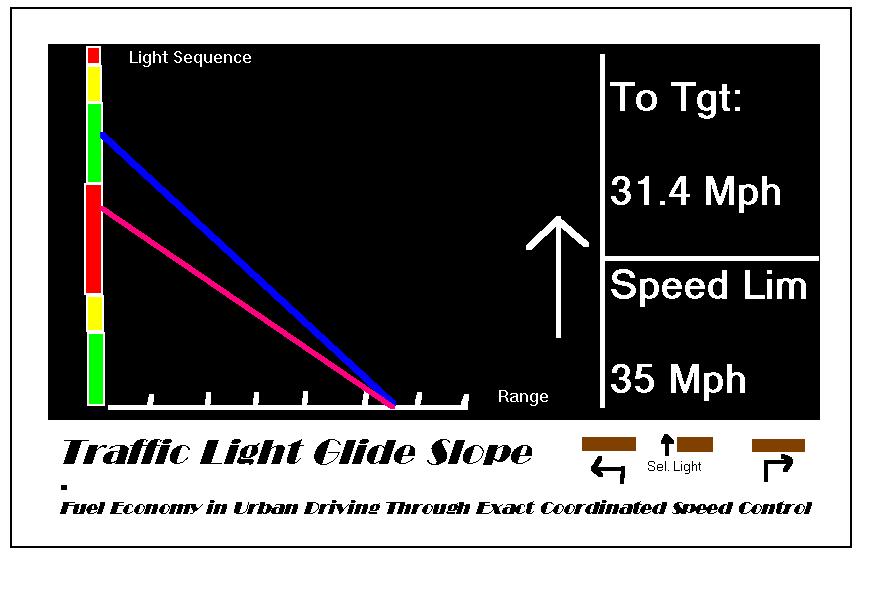
(June 27, 2000)
The efficiency of automobiles could be radically increased by better gathering and use of information at very little cost. Electronic instruments can provide information permitting the automobile to be driven in optimum fashion. A wide variety of advantages would ensue, with few if any countervailing disadvantages.
Let us take as a notional automobile, one with a highway gas mileage of 40 MPG (*), a city gas mileage of 20 MPG, and a composite gas mileage of 25 MPG, reflecting the preponderance of city driving. City driving means driving at comparatively low speeds, for example, a peak speed of 40 MPH, an average speed while rolling of 25 MPH, and a trip average of 15 MPH. The poor gas mileage is almost exclusively due to acceleration and deceleration, and idling at stop lights. Automobiles with regenerative braking systems have city gas mileage (or range in the case of an electric vehicle) almost as good as their highway gas mileage, but no better, despite the considerably lower speeds. However, an automobile moving at city speeds under highway conditions (ie. a uniform speed of 30 MPH without braking or acceleration) can attain much higher gas mileages, on the order of 60 MPG or more, with a higher average speed than under the conventional regime. Furthermore, the composite average of such an automobile would be upwards of 50 MPG.
The forgoing, of course, presupposes the existence of a road system in which automobiles can move at a uniform 30 MPH without stopping. One possibility would be to build a system of "sub- freeways, differing from conventional freeways only in lower speed limits, steeper grades, smaller turning radii, and correspondingly smaller on-ramps and intersections. This would, however, be a comparatively expensive proposition. Another, and more interesting possibility, is for motorists to synchronize themselves with the traffic lights-- that is, to drive at a speed calculated to bring them to the next traffic light in the middle of the green phase. It is sometimes possible to do this, given sufficient local knowledge of the way particular traffic lights are configured, but this method is not generally practical for want of information.
Very well, drawing loosely on aircraft navigation instruments, let us hypothesize an instrument designed to provide the information an automobile driver needs in order to consistently use this optimal mode of city driving. Selected roads would be equipped with some kind of radio transmitter, designed to indicate the distance and timing of the next traffic light. This transmitter system would not necessarily mean tearing up the streets; it could be "piggybacked" on the Global Positioning System, in which case it would only be necessary to add a small module to selected traffic lights, those on major urban arteries. Automobiles would be fitted with suitable receivers, and displays designed to present the information in useful form. I have drawn a "mockup diagram" of a possible display. The system could of course be linked to Cruise Control as well.
General use of this system would probably be sufficient to turn the United States from an oil importer to an oil exporter, with no loss of convenience (indeed, average trip speed might well increase), and with the expenditure of only a modest amount of capital, on the order of ten billion dollars (a hundred dollars per automobile or forty dollars per capita), for initial equipment.
A further advantage would be to permanently diminish the revenue of the oil states, and to set sharp restrictions on their procurement of advanced armaments. There is an old saying to the effect that "you can't spank the monkey while he's on your back." It applies forcibly to the oil states. Within a few years, it might well prove possible to decrease the defense budget by fifty billion dollars annually, reflecting a less dangerous world. There would also be a corresponding reduction in pollution, global warming, etc. In short, to use David Suzuki's phrase about compact fluorescent lamps: "this isn't just a free lunch-- it's a meal they pay you to eat!"
Andrew D. Todd
1249 Pineview Dr., Apt 4
Morgantown, WV 26505
adtodd@mail.wvnet.edu (formerly U46A8@WVNVM.WVNET.EDU)
(*) Please note that all numbers in this paper are "guesstimates." While I should be surprised if they were more than twenty percent wrong, they are not exact, and should not be taken as such.
